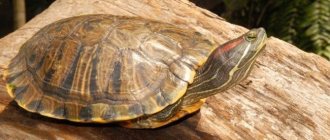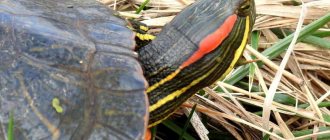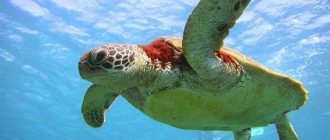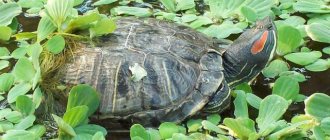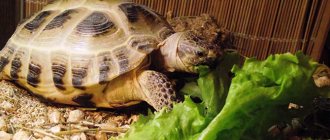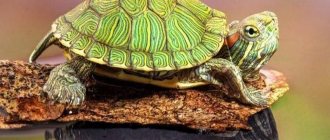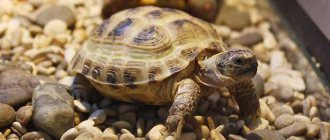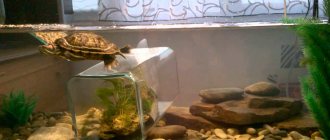Review author: “ZooVita”
All turtles, according to their way of life, are divided into two large groups: land and aquatic inhabitants. At home, you can only find representatives of the second group, because today there are very few land reptiles left (declining population numbers).
Photos of various representatives of aquatic turtles will allow you to familiarize yourself with the features of the external structure and habitat.
Conditions at home
Due to its unpretentiousness, omnivorous nature and tolerance to room temperatures, the musky turtle is a favorite inhabitant of home terrariums.
Although when caught, the animal shows a rather warlike character, biting and breaking free, but after some time spent in captivity, it becomes quite peaceful. An additional method of protection for this reptile is a yellowish, sharp-smelling secretion secreted from a gland located under the shell. Its lifespan in captivity is more than 20 years.
Specialized publications indicate the need to equip a shallow reservoir with a water height of no more than 15 cm, but practice has shown that this is not at all necessary.
A fairly well-known turtle breeder, Gerhard Müller, states that he kept his musk turtles in aquaterrariums with a water level of about half a meter, and in natural conditions they usually live at a depth of up to 85 cm. Some difficulties with adaptation arose only with individuals received from other terrarium keepers, however , after a short time, they also adapted.
It is quite difficult to recreate the muddy bottom to which musk turtles are accustomed in their natural habitat, so in home aquariums washed river sand, strong branches, stones, decorative roots, as well as green spaces are used, which improve the condition of the water and serve as additional food for the reptiles.
Common musk turtles are big messy creatures, so be prepared to either invest in a fairly powerful filter or change the water every few days. Pay attention to the fact that all accumulated droppings and dirt are removed along with the sucked water, and that the fresh water poured in is the same temperature as the old one. It is best to use settled water, from which all the chlorine has already been removed. It is recommended to maintain the tank temperature within 22-30⁰ C, and the ambient temperature should fluctuate approximately within the same range.
Try to diversify your turtle's diet as much as possible. It should consist of:
- Dry food;
- Live food (snails, tadpoles, frozen shrimp, lean veal, earthworms, bloodworms, small fish);
- Plant foods (lettuce, cabbage, duckweed).
During the period of egg laying inside the aquaterarium, it is necessary to separate the artificial shore from the water part; for this, an inclined glass plate is installed. If this is not available, you can use a homemade sand mound or ordinary brick. On a bank adapted for laying eggs, it is necessary to install a ditch with washed river sand.
Central European breeders often release musk turtles into small outdoor ponds during the summer, so the animals spend time almost in their natural habitat.
If you have the opportunity to provide turtles with a large aquaterrarium and eliminate the moment of competition while eating, then this type of reptile can be kept in small groups.
If, under terrarium conditions, you do not arrange “wintering” for musk turtles, then the males will strive to mate with females all year, alternating periods of activity with periods of rest. However, the peak of “courtship” still occurs on warm, sunny spring and summer days if kept outdoors. Common musk turtles do not have any mating dance, and the mating process takes from 60 minutes to a day.
What to feed a freshwater turtle
Having dealt with the question of how to care for a turtle, it’s time to find out what reptiles eat. The diet largely depends on the age of the animal - very young children receive all the necessary nutrients from a special gall sac, which is located on the plastron. While the cub is feeding on the gall sac, it does not need additional feeding. Young reptiles can be fed small crustaceans, vegetables and, of course, specialized food with calcium supplements. During this period, the shell is actively growing, and the lack of the main element for its structure can negatively affect the health of the turtle.
What do aquatic turtles eat? Plant food, animal food and artificial food. At the same time, food from a pet store should make up about 50% of the total diet. The diet should be varied - lettuce, dandelions, clover, algae, mussels, shrimp, snails, raw fish and chicken. The portion depends on the animal's appetite. Young animals should eat at least once a day. Adults can be fed once every 2-3 days.
Land turtles
Living conditions, feeding and bathing
For land turtles, a terrarium is usually prepared, but if one is not available, an ordinary cardboard box or plastic container will do.
The bottom of the container is covered with clean hay or sawdust. It is not recommended to use soil or sand. In order for the turtle to periodically grind down its claws, it is worth placing several large stones in the terrarium.
The terrarium must be equipped with an infrared heater or incandescent lamp. To prevent the turtle from suffering from lack of sunlight, you should install an ultraviolet lamp.
Turtles do not really like attention to them and often hide. Therefore, you can build a “house” for them. You can make it from a flower pot cut lengthwise, half of which will become a shelter for your pet.
Land turtles love to eat vegetables (mashed carrots, zucchini), fruits (apples and others), dandelions and lettuce. Dandelions can be dried for the winter.
Turtles “drink” through their skin, so they should be bathed at least once a week. For this, the water temperature should be about +32C, and its level should be up to the middle of the shell.
Land turtles need to be cared for especially carefully during their molt. To do this, add baking soda to the water while bathing (one teaspoon per liter of water). During molting, the pet bathes in this solution no more than twice. Do not lubricate the shell with lotions or oils. They only clog the pores on the skin, but have practically no benefit.
In summer, at temperatures above +20C, land turtles can be walked. A green lawn with dandelions and clover growing is suitable for this.
Having created all the necessary conditions for your pet, he will feel good and comfortable throughout his many tortoise years. Do not forget that an animal is still not a toy, but a creature that needs care and attention.
How to arrange housing for a turtle?
As a rule, red-eared turtles are kept at home. Its home is an aquarium, which has a small plot of land or an aquaterrarium. The shore or land for a sea turtle must be equipped with an accessible approach so that the animal can always climb onto it without obstacles.
The shore must be designed in such a way that the water flowing from the turtle cannot stagnate in it. An aquatic turtle must be able to dry out its shell. A heating lamp with a power of forty to sixty watts is installed at a height of twenty-five to thirty centimeters above the land area. It is prohibited to place the lamp below, as the turtle may overheat.
Caring for such a pet requires having a fairly large home. If the aquarium will contain several animals, its dimensions must be appropriate.
Caring for large individuals will be much more difficult, since their maintenance will require housing exceeding several hundred liters. When buying an aquarium for a turtle, it is worth remembering that some breeds can grow up to 18-28 centimeters.
A domestic turtle can be kept in either a glass or plastic aquaterrarium, in which an aquarium filter and a heater must be installed, corresponding in power to the volume of infused water. Caring for a red-eared turtle requires compliance with the correct temperature conditions: the optimal water temperature is 26 degrees and the air temperature on the shore is at least thirty degrees.
For aquatic turtles, it is necessary to use an aquaterrarium, and in no case should they be kept on free grazing - that is, on the floor or in other “natural” conditions.
For normal life and growth of a turtle, an ultraviolet lamp is required. Such a device will ensure proper care for it, since ultraviolet radiation replaces sunlight, which promotes the absorption of calcium in the turtle. It is best to choose a lamp with five percent UVB.
The pet turtle should be kept in an aquaterrarium throughout the day. Only when feeding and cleaning her house is the pet placed in another container with water. To ensure proper care for the turtle, you should not let it go on the floor, as the animal may get sick or injured.
Main types of aquatic turtles
Three groups are recognized as the most popular species of domestic aquatic turtles:
- Pond slider.
- Chinese Trionics.
- Swamp turtle.
For each variety there are a number of characteristic external features by which reptiles can be distinguished from each other.
How long does the red ear live and where does it live?
This type of turtle can rightfully be considered a long-liver. In favorable conditions, life expectancy is 40 years. An interesting fact is that the red-eared turtle has a high level of intelligence, not typical of other reptiles. These animals are very sensitive to vibrations and their behavior can warn of an impending earthquake or storm. When choosing food, the red-eared turtle first focuses on the color, and only then on the smell and taste of the object.
These reptiles are widespread in nature. They can be found in their natural environment in Central and South America, Israel, South Africa, Spain and even Great Britain. But in Australia, this species is officially recognized as a pest, since it destroys local endemics. The red ear lives in shallow ponds and lakes, and in other bodies of water with swampy shores.
Keeping this exotic animal turns out to be much more difficult than initially thought. These turtles spend most of their time in the water, although they need land. For one adult, an aquaterrarium with a volume of 120-150 liters will be comfortable, while land should occupy no more than 25% of the total area. On the improvised bank, special soil or crushed stone should be poured, making a gentle rise. The turtle's shell must fit completely in the water so that the animal can easily roll over onto its back and back.
For this type of amphibian, the optimal temperature is 25-30 degrees Celsius. When the temperature drops to 20 degrees, hibernation may occur in red-eared turtles. The water in the aquarium is changed as needed, at least once a month. In order for the turtle to be healthy, it also needs to be provided with portioned irradiation with an ultraviolet lamp.
Interesting Facts
Turtles have lived on Earth for a very long time. In the process of evolution, they were able to successfully adapt to the changing conditions of nature.
The reptiles of this order, living in water, play an important role in various ecosystems and never cease to amaze with the peculiarities of their existence. Here are just a few of them:
- The largest is considered to be the leatherback turtle, whose weight sometimes reaches 900 kg;
- a sea turtle called Archelon that lived in ancient times had a body weight of more than 2 tons;
- There are poisonous turtles, for example, the leatherback (its diet includes poisonous jellyfish, which make the flesh of the turtle poisonous);
- the same leatherback turtles are capable of diving to great depths (more than a kilometer), and the enormous water pressure does not harm them;
- in water, unlike land, turtles can reach speeds of 35 km/h;
- large sea turtles understand the communication language of dolphins;
- turtles are perfectly oriented in space thanks to the Earth’s magnetic field;
- marsh turtles, if necessary, can starve for 4-5 years;
- Blanding's turtle thrives in the cold climate and waters of the Canadian Great Lakes, unlike all other heat-loving relatives;
- The leatherback turtle does not have a hard shell
Diseases
Despite the endurance and resilience of red-eared turtles, sometimes due to errors in keeping the reptiles get sick and die. Knowledge about common turtle ailments and treatment methods will help you avoid such consequences:
- Pneumonia - the disease develops due to being kept in cold water or lack of food. Symptoms include hoarse breathing, lethargy, weakness and pallor of the mucous membranes. Treatment is carried out using an injection of Baytril 2.5% - 0.4 ml/kg into the brachial muscle.
- Bone ailments - if white spots on the shell and detachments are detected in a red-eared turtle, we can conclude that there is a fungal infection. Pets are treated with Clotrimazole ointment, treating damaged areas.
- Lack of calcium - with this problem, reptiles' shell peels off. The deficiency can be eliminated by giving pets small fish with bones and calcium supplements.
Red-eared turtles are funny and interesting pets that, instead of trouble, bring only joy and tenderness to their owners. Considering the attractiveness, endurance and unpretentiousness of reptiles, even an inexperienced owner will be able to raise and reproduce turtles at home, following the rules and recommendations for care.
Feeding features of aquatic turtles
The diet of aquatic reptiles is varied and has an approximately equal ratio of plant and animal foods. How to feed aquatic turtles:
- In zoological stores you can buy ready-made food for your pets, which contains all the necessary ingredients balanced.
- For variety, you can feed your pet turtles worms, insects, shrimp, or small fish. Various vegetable mixtures are excellent as a source of fiber and vitamins.
- Be sure to periodically introduce vitamin D and calcium into the diet, which are necessary for healthy shell growth.
In the wild, turtles feed on small insects, flies, dragonflies, frogs and even small fish.
The plant component is marsh grass, algae, and plant leaves. On land, these types of reptiles cannot feed because they need water to swallow food.
Pond slider
It is called so because of the pair of yellow, orange or red spots on the head - “ears”, located on the sides of the head. The length of the carapace ranges from 11 cm to 60 cm, depending on age. The shell has a rounded-oval streamlined shape, covered with horn-like plates-scutes, on the limbs the fingers are connected by membranes, the fingers themselves end in sharp claws. The head is covered with soft skin.
Let's start from the beginning - with the “house”. To keep freshwater turtles, a horizontal aquaterrarium is required, since area is more important to them than height. The aqua terrarium should be spacious enough for the turtle to move freely in it. Its size should depend on the size of the animal. The water part should be about 2/3 of the area of the terrarium, its depth depends on the size of the turtles. The shore of the pool should be flat, as in natural conditions, so that animals can easily get out of the water.
The main factors for successfully keeping reptiles at home: lighting, temperature, ultraviolet light, water filtration.
One of the most important factors is lighting. It is practically impossible to over-light a terrarium, and saving on lighting is unacceptable. Turtles are children of the sun. Turtles living in home aquaterrariums need additional ultraviolet irradiation, since a lack of ultraviolet radiation causes various diseases. There are now many varieties of imported UV lamps on sale with different powers and different sizes, designed specifically for reptiles.
The water in the terrarium must be filtered through a relatively large and powerful filter. However, even with constant filtration, it is necessary to do a complete or partial change of water.
Every terrarium must have good ventilation. The only thing is that you should not confuse ventilation with drafts. Reptiles are afraid of drafts and are susceptible to colds. The temperature of water and air should be approximately equal.
Young turtles need to be fed once a day, and adult turtles once every few days. You need to feed turtles either ready-made food from imports, or homemade food, but with the addition of vitamin and mineral supplements. If you decide to feed your turtle food prepared at home, then it should consist of: lean sea fish, shrimp, squid, hamarus, bloodworms, mollusks, small aquarium snails, etc.
Breeding
Domestic reptiles reproduce well in captivity. Females regularly lay eggs, but they may not be fertilized. For full reproduction, naturally, two turtles of different sexes are needed. At home, reptiles mate most often from February to May. In addition, you can slightly stimulate the beginning of their mating. To do this you need to raise the temperature a little.
Before the start, the male courtes his “lady” in a very interesting way. He begins to swim in front of her, tail first, then tickles her cheeks with his claws. Sometimes the males begin to hit the female with their shell. If the female is ready to mate, then she allows her chosen one to approach her. This usually happens in water and lasts no more than 15 minutes. This is enough to lay 4 to 5 clutches of eggs.
In its natural environment, the turtle begins to lay eggs from the beginning of April. Laying lasts until September. First, she wets the sand with her liquid, then digs a hole up to 20 centimeters in diameter. After this, it lays from 5 to 15 eggs in it and covers them with sand. In order for the reptile to do this in the aquarium, it is necessary to make an artificial beach for it. To do this, you need to place a cuvette with slightly moistened sand in it, the layer of which will not exceed more than 5 centimeters. So that the turtle can easily climb there, you need to make a special ladder and carefully attach it to the ditch.
If the reptile laid eggs directly into the water, they should be immediately removed from there and placed in the sand. Most often, experts recommend buying a separate aquarium for the duration of mating. Its volume should not be less than 100 liters, and fill it with water to about 10 centimeters. The mating process and its consequences must be monitored. The future of the offspring depends on this. If mating does not occur, then the couple should be seated separately and only after a while should the pairing be repeated again.
Water purification in an aquaterrarium
Aquatic turtles primarily feed on highly perishable food. In addition, the excretions of these animals significantly pollute the water. Previously, the owners of these pets had to change the water several times a week. However, now caring for them has become much easier thanks to the emergence of a variety of modern filters.
Aquaterrariums for turtles are a magnificent decorative element that can decorate almost any interior.
In small aquariums with small specimens, conventional internal filters equipped with a sponge are installed. Many models of such filters are suitable for small bodies of water. They do an excellent job with fairly small and large particles of dirt.
Recently, special devices that simplify the care of aquaterrariums, such as “biological filters,” have become popular. They use special bacteria that are used to remove nitrogen compounds.
Pet stores also sell specialized fillers made by foreign manufacturers. Such filters help keep water clean for a long time and do not allow bacteria to grow in it.
What happens if you turn it off often?
When the filter is turned off, organic waste from fish and uneaten food begin to rot, releasing toxic compounds into the water.
At the same time, without air supply, nitrifying bacteria die in the filter, which neutralize the decay products of organic substances in the water.
After turning on the filter, the entire mass of dead bacteria is released into the water, polluting it even more. The colony of nitrifying bacteria is restored slowly.
In an overcrowded aquarium with no living plants, turning off the filter for a long time means poisoning the inhabitants of the home pond.
An aquarium in which:
- Unpretentious fish live. Ancistrus, gouramis, neons and guppies can easily survive for some time without water treatment.
- There is a small population. The fewer inhabitants, the less organic waste ends up in the water. Experienced aquarists advise populating the container according to the following scheme: per 1 cm of body length of an adult, there should be at least 1 liter of water.
- A lot of plants. Plants are able to absorb organic compounds, and they also enrich the water with oxygen. Plants in large numbers can temporarily take over the function of maintaining cleanliness.
Only if the conditions described above are met, periodic short-term switching off of the filter will not be too critical for the aquarium.
water turtle
What to look for when buying an aquatic turtle:
- Behavior: coordination of movements, activity.
- Appearance: the shell must be of the correct shape with even, adjacent shields. There should be no damage or unwanted stains on it.
- The oral mucosa in healthy reptiles is light pink in color, without whitishness or plaque.
- The turtle's breathing should be silent.
- There should be no discharge from the nose and mouth.
Water turtle at home
To keep a turtle you need an aquarium, the volume of which depends on the size of the reptile. Its width should be twice as large as its height. When choosing an aquarium, keep in mind that small turtles grow quickly. However, it is not worth purchasing it for “growth”. In a large aquarium, a small turtle will feel uncomfortable. It is best to first buy a small, inexpensive aquarium, and then replace it with a larger one.
Setting up an aquarium and caring for turtles
You should immediately pay attention to the fact that the plastic island is inconvenient. The turtles slide off it. It is best to choose a rough, gently sloping bank.
The land in the aquarium should occupy approximately one-fourth of the total area. It is necessary to leave at least thirty centimeters of space from it to the edge of the container. Otherwise the turtles may escape.
If you install a yellow incandescent lamp above the island, then the water in the aquarium does not need to be heated. The water should not heat up more than twenty-one degrees. It should be changed quite often to prevent a musty smell. This negatively affects the health of pets.
It is better to remove small turtles from the aquarium and place them in a warm and dry place. For example, in a box covered with a towel. Then they will grow and develop better.
Nutritional Features
Small turtles should be fed every day. As they grow older, the number of meals is reduced to once every three days. Sometimes turtles may refuse food, then they need to be fed with guppy fish.
The diet of aquatic turtles must include lean meat (beef, chicken, turkey) and chopped vegetables. It is recommended that adult reptiles be fed supplements containing microelements, calcium and vitamins necessary for the proper development and growth of an aquatic turtle.
I want to keep turtles in an aquarium, I just heard... that they can eat fish... is that true?
Fronder
Freshwater turtles should not be kept in an aquarium with fish. Firstly, turtles eat fish, shrimp, snails and other aquarium inhabitants. They also feed on aquatic plants. Secondly, an aquatic turtle needs not only a shore with convenient access to it, but also an incandescent lamp for heating and a Repti Glo 5.0 UV lamp for irradiation on the shore. This option is not suitable for fish. Thirdly, turtles are dirty, the water quickly becomes dirty, even if you feed the turtle in a separate container. An adult turtle defecates a lot and constantly. The water has to be changed more often than for fish. Moreover, it will be necessary to change completely periodically. And this is terrible stress for fish. The fish weakens and is eaten by the turtle. What if it doesn't get eaten? but it gets bitten and the fish eventually dies. And again it is eaten by the turtle. Turtles need an aquaterrarium. and you can put feeder fish there. The turtle hunts it with pleasure. Here I describe in detail and with photos the maintenance of red-eared turtles, maintenance, disease prevention and some symptoms of diseases. https://otvet.mail.ru/question/18308296/ All the information will not fit here. And the photo limit has run out, but this information has been tested by time and from my own experience. I have four red-eared turtles living in a homemade aquaterrarium. In addition, I have five aquariums with fish, crayfish, shrimp and one clawed frog.
Lizaveta Borisovna
They still eat, especially when they grow up. Keep a low profile with fish, they make a lot of dirt! It’s better to keep them in a plastic basin, anyway, you always have to change the water, There’s a lot of hassle, but they live a long time1 THINK 100 times!
